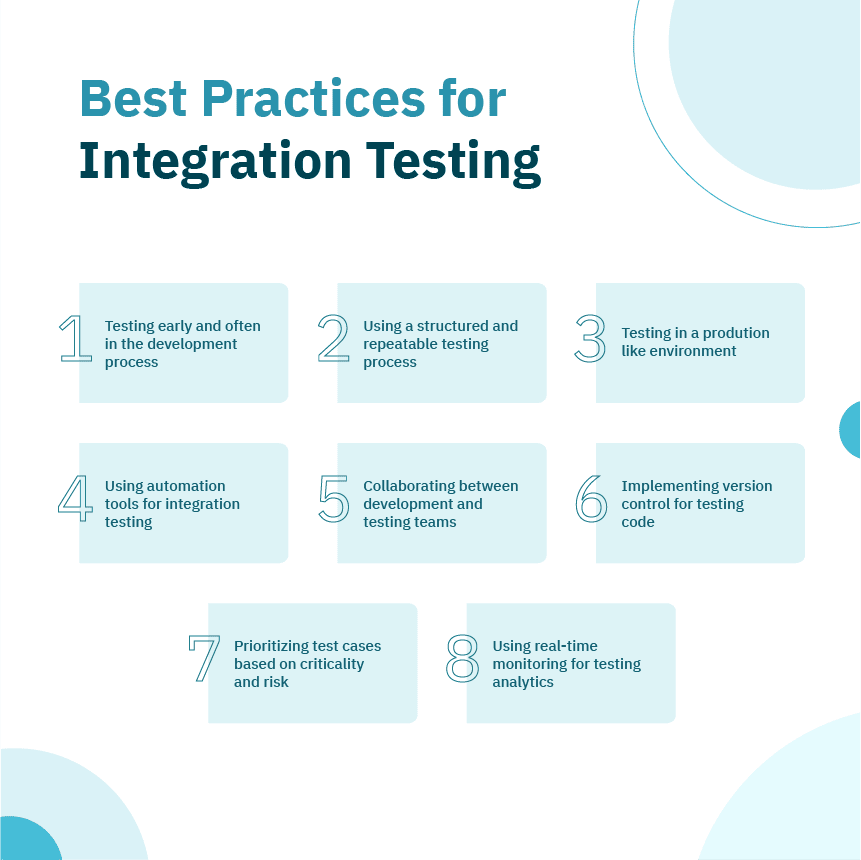Integration testing is a critical software testing process that verifies the interface between two or more software components, subsystems or systems ensuring that they work together as intended.
Importance of Integration Testing in Software Development
Integration testing is essential to ensure that the different software components are integrated seamlessly and work together without any errors or bugs. It plays a significant role in delivering high-quality software that meets customer expectations and specifications.

Integration Testing Best Practices
A. Testing early and often in the development process
What is the best time to perform integration testing? Integration testing should start as early as possible in the software development lifecycle and continue throughout the process. This helps identify issues early on, which can save time and resources in the long run.
B. Using a structured and repeatable testing process
A structured and repeatable testing process ensures that integration testing is done consistently and effectively. This includes developing a testing strategy, creating test cases, executing tests, and reporting results.
C. Testing in a production-like environment
Testing in an environment that closely resembles the production environment helps ensure that the software works as intended in real-world scenarios. This can help avoid potential issues when the software is deployed.
D. Using automation tools for integration testing
Automation tools can help streamline the integration testing process, reduce testing time and effort, and increase testing accuracy. This includes integration testing tools for test case management, test automation, and continuous integration.
Want to learn more about continuous integration testing best practices. Read more.
E. Collaboration between development and testing teams
Effective collaboration between development and testing teams can help identify issues early on, facilitate communication, and ensure that everyone is on the same page. This can help improve the quality of the software and reduce development time.
F. Implementing version control for testing code
Version control helps manage changes to testing code and ensures that the latest version is always used. This can help avoid errors and ensure that the testing process is consistent.
G. Prioritizing test cases based on criticality and risk
Not all test cases are equally important. Prioritizing test cases based on criticality and risk helps ensure that the most important aspects of the software are thoroughly tested first.
H. Using real-time monitoring for testing analytics
Real-time monitoring can provide insights into how the software is performing in different environments and help identify issues early on. Additionally, it can provide valuable data for improving the software.
These practices, along with the right steps for how to test integration testing with examples, is surely the best way to make integration testing easier.
What is the most popular integration testing approach? Read more.
Challenges with Integration Testing and how Intelligent Automation could be the best solution!
- Complex systems and dependencies: Automation can help in setting up a testing environment that simulates the real-world conditions of the system and its dependencies. This can help in identifying and fixing issues before they become critical.
- Integration testing across multiple platforms and devices: Automation can help in creating test scripts that are platform- and device-agnostic, thereby reducing the effort required to test across multiple platforms and devices.
- Difficulty in identifying and isolating defects: Automation can help in quickly identifying defects by running a large number of test cases in a short time. It can also help in isolating defects by providing detailed reports and logs.
- Lack of collaboration between development and testing teams: Automation can provide a common platform for test design, execution, and reporting, thereby facilitating collaboration between development and testing teams.
- Limited resources for testing: Automation can help in optimizing testing efforts by automating repetitive and time-consuming tasks, thereby freeing up resources for more critical testing activities.

Final Words
Integration testing plays a crucial role in software development by ensuring that different components of a system work together seamlessly. However, it can also be challenging due to the complexity of systems, dependencies, and the need to test across multiple platforms and devices.
These challenges can be overcome by following best practices such as testing early and often, using a structured testing process, and collaborating between development and testing teams.
Automation tools can also be instrumental in optimizing testing efforts and ensuring successful integration. With the right approach and tools, integration testing can lead to more reliable and efficient software systems that meet the needs of users and stakeholders.






